The use of copper sulfate in gardening in spring and autumn: when and how to process
Copper sulfate is an extremely necessary preparation (fungicide and antiseptic) in the garden, in particular for eradicating and preventive treatment of trees and shrubs in spring... It is inexpensive, and it will bring a lot of benefits, if, of course, you use it correctly (in the right concentration).
As for its (copper sulfate) use in horticulture and horticulture, it is by no means difficult, since, in principle, it repeats the application ferrous sulfate, of course, with its own characteristics, which we will talk about in more detail later.
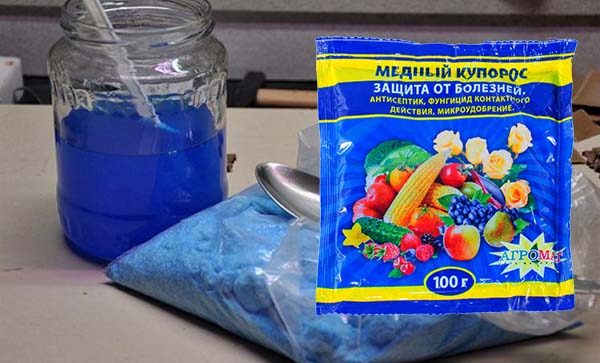
Content
What is copper sulfate: composition and form of release
Copper sulfate is otherwise called bivalent copper sulfate or copper sulfate (again, bivalent).The appearance of the product is blue small crystals (powder). It dissolves well in water.
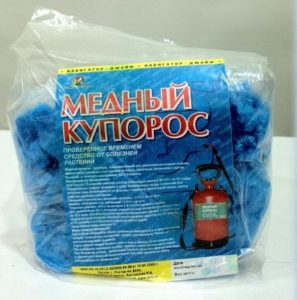
Interesting! Copper sulfate is sold both in garden centers and in hardware stores. Typically, a package weighs 50, 100, 200 or 300 grams.
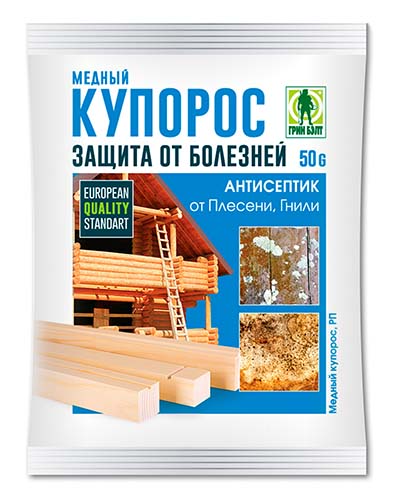
It gained such distribution in everyday life due to its versatility and antiseptic properties. Thus, in construction, it can be used to process wood (to prevent rotting, neutralize the effects of leaks, eliminate rust stains, and also use it to remove salt precipitates (so-called "efflorescence") from brick, concrete and plastered surfaces. for the manufacture of mineral paints, for removing rust stains on the ceiling after flooding, for detecting the presence of zinc, manganese and magnesium in aluminum alloys and stainless steel (in the presence of these metals, red spots appear), and, of course, copper sulfate most widely used in the garden and vegetable garden.
How can copper sulfate be used in gardening: spheres and methods
The main purposes of using copper sulfate in the garden and vegetable garden:
- for whitewashing trees;
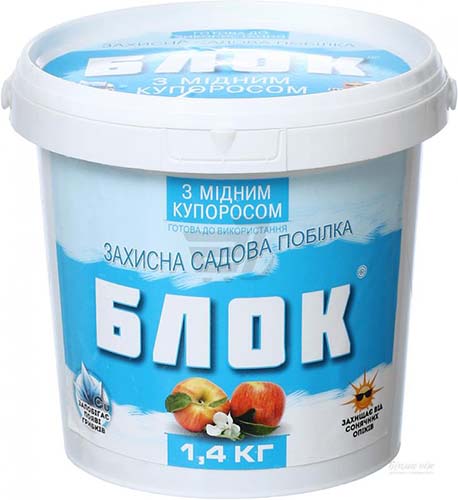
-
By the way! About, how to whitewash trees in autumn and spring, read in this article.
- for eradicating treatment (in the spring and in the fall);
- for spring preventive treatments for fungal diseases (trees and shrubs);
Note! The site already has separate detailed material about how to carry out spring spraying gooseberry, currants, apple trees, cherries, peach, grapes, strawberry, raspberries.
- from late blight (potatoes and tomato);
- disinfection of wounds (after pruning), cracks and hollows in trees (1% solution);
- for fertilization (replenishing the copper deficiency in the soil);
- for disinfection of the roots of seedlings roses, berry bushes and fruit trees in order to prevent fungal diseases (lower the roots for 3 minutes in a 1% solution, and then rinse under running water);
- for spring and autumn processing of the greenhouse.
Below you will find detailed information on each area of application of copper sulfate in the garden, as well as the proportions in which it should be diluted (mixed with water and other means).
Treatment of wounds, cracks and hollows in trees
To disinfect tree wounds, a 1% solution (100 g per 10 l) of copper sulfate is used, which must be applied to the damaged areas (cuts).
Eradicating spraying
Spend eradication of tree spraying this solution can be in the spring at rest (the kidneys have not yet opened) or along a green cone (a state when the buds have just burst, but the leaves have not yet begun to unfold).
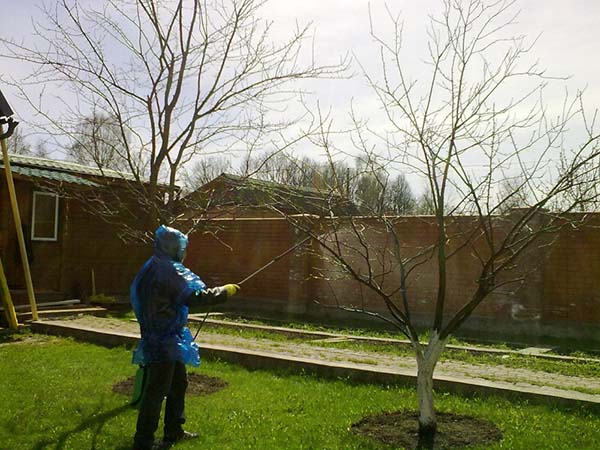
The main goal early spring eradicating spraying of the garden is the destruction of hibernating spores, so as not to give any chance of survival for the awakening pathogens.
For eradicating treatment, you need to prepare a 1-3% solution of copper sulfate, in which, if desired, to enhance the effect (against the larvae of insect pests), you can add urea (5-7% solution), as well as 200-250 ml of liquid soap or dishwashing detergent (for better adhesion).
Advice! To enhance the action of copper sulfate 30-50 ml of 10% should be added to the solution ammonia (ammonia).
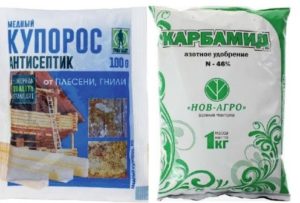
By the way! In early spring, as a rule, it is a 3% solution (300 grams per 10 liters) of copper sulfate (but 1% is possible, but not less). If you decide to mix copper sulfate (3%) with urea (5-7%), then you need to do this in one bucket (300 grams of vitriol + 500-700 grams of urea + 10 liters of water, not 20).
Basically (however, this is not very popular and not recommended by everyone), eradication spraying can be carried out in the fallwhen foliage begins to fall. Wherein it is desirable to have time to carry out processing on foliage (in this way it "burns out" along with all the spores of pathogens and will quickly fall off), although it is possible after falling leaves (already simple on trunks and branches, and on the soil in the near-trunk circle).
Important!Solution concentration at autumn processingusually depends on whether the culture has been sick this season. If so, it is better to use a 3% solution (300 grams per 10 liters). It's another matter if this season everything worked out. Then a 1% solution (100 grams per 10 liters) is suitable. But for processing very young plants, it is always better to prepare a 1% solution (100 grams per 10 liters).
Video: processing trees and shrubs with copper sulfate
Preventive treatment
It is worth understanding! Copper sulfate is not a medicinal product, but a prophylactic (protective) one, and if the spores of the fungus have already entered the tissues of leaves and fruits (i.e. the plant is already sick), then the remedy will be powerless.
It should be borne in mind that young leaves are very sensitive to the damaging effect of copper sulfate (and it is quite phytotoxic), so it is better to turn it into a form that is more gentle for plants (read how to do this below).
Note! A recipe from an expert procvetok: dissolve 150 g of copper sulfate and 100 g of alkali (for example, "Mole") in a bucket of 3-4 liters of water. Stir, wait for the sediment to settle, and drain the liquid that is on top as much as possible. Then add 9% table vinegar or another concentration to completely dissolve the resulting precipitate (you will need up to 1 liter of 9% vinegar or much less if you use the essence. Once it dissolves, no more vinegar is needed). You end up with copper acetate. The volume must be brought to 10-12 liters, add liquid soap and use the solution for treating the garden and vegetable garden, i.e. for the prevention of fungal diseases.
Important! If you have no alkalithen her can be replaced with soda... It must be added until all the vitriol precipitates, and the liquid becomes colorless rather than blue. But you should be prepared for the fact that when you dissolve the sediment with vinegar, carbon dioxide will be released. This is normal and it should be.
Video: preparing a gentle solution of copper sulfate for processing plants
However, the older the leaves become, the less they are sensitive to the damaging effect of copper sulfate. Therefore, for sheet processing, you can use a pure 1-1.2% solution of copper sulfate.
Copper sulfate can also be processed during fruiting. The solution is well washed off earlier (especially if washed thoroughly), but it is better to wait 7 days.
Important! A solution concentration of less than 1%, for example 0.9%, is considered ineffective. More than 1.2%, for example 1.5% - can cause serious damage even in mature plants.
Copper sulfate is quite effective in combating (more precisely, in preventing) the following diseases in various crops:
- on pome fruits (apple, pear, quince) against fruit rot (moniliosis), scab, phyllostictosis and other spots;
- on stone fruits (apricot, plum, peach, cherry and sweet cherry) from cloisterosporium disease, coccomycosis, moniliosis (monilial burn), peach leaf curl, coccomycosis and other spots;
- on berry bushes (currants and gooseberries) against anthracnose, septoria and other leaf spots;
- downy mildew - mildew (grapes);
- grape anthracnose;
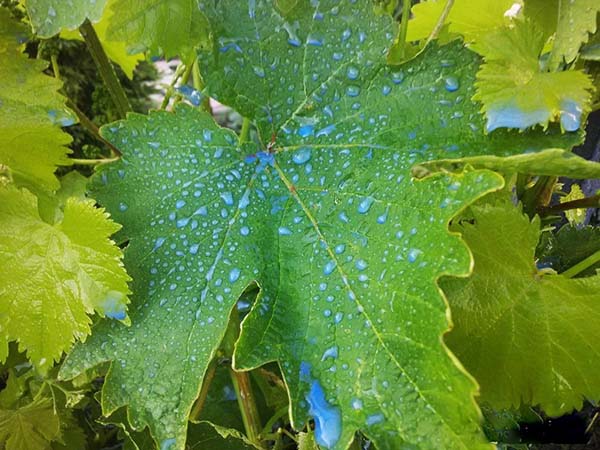
- powdery mildew (especially in roses and ornamental shrubs);
- from late blight (more details below).
Note! Copper sulfate is a fungicide contact action, that is, it does not penetrate inside and does not accumulate in the tissues of the plant, but acts only on its surface and, therefore, is easily washed off by rain. Therefore, as a rule, several treatments are required (especially after rains).
From late blight
Late blight is a fairly common and very destructive disease, which affects many garden and horticultural crops, primarily the nightshade family -tomatoes and potatoesas well as peppers, eggplant and physalis. And sometimes even strawberries (garden strawberries), apple trees, castor oil plants and buckwheat can be affected by late blight.
To prevent late blight, you can treat the seedlings with a solution of copper sulfate:
Note! As a rule, in many sources the recommended concentration for solution preparation is 0.2-0.5%, i.e. 20-50 grams per 10 liters (but a solution of less than 1% is considered ineffective), therefore it is better to prepare according to the recipe given in the previous paragraph "Preventive treatment", while increasing the volume of the solution to 12, not 10 liters.
- even before disembarking, and then after 10-14 days, repeat the treatment;
- at the first signs of the disease (for example, if the disease has so far manifested itself only on tomatoes, other crops should be promptly processed);
- for prophylaxis in the event of a threat of a disease (if the weather is favorable for its spread - dampness and high humidity (frequent rains), the air temperature is about 20-25 degrees).
Advice! In a protected ground (greenhouse) it is better to use exactly copper sulfate, and in the open field - Bordeaux mixture (liquid), since copper sulfate is easily washed off by rain, while Bordeaux liquid eats into the leaves and is not washed off with water.
Microfertilizer
By the way! The lack of copper in the soil in the plant is manifested by whitening of the tips of the leaves.
If there is a lack of copper in the soil, you can spill the earth (1 liter per 1 sq. M) with a solution of copper sulfate (5-10 grams per 10 liters) or add it dry at the rate of 1 gram per 1 sq. M. In addition, this will disinfect the plant's near-stem circle. As a rule, such feeding with copper sulfate is required for sandy or peaty soils, in which there is practically no copper (once a year). On other types of soils (richer), to replenish the supply of copper, feeding with copper sulfate is recommended once every 3-5 years.
Worth knowing! You should not add an excessive amount of copper to the soil, because it has the ability to accumulate, and with its excess, plants begin to receive less iron.
General tips for using copper sulfate: how and when (autumn and / or spring) to process the garden
When carrying out processing, be guided by the following rules for the use of copper sulfate:
- It should be borne in mind that copper sulfate, being an acidic salt, slightly increases the acidity of the soil.
- Processing follows carry out only at positive temperatures (preferably +5 and above), and preferably in cloudy but calm weather, early in the morning or in the evening.
- Dilute copper sulfate should only in glass (for example, a jar), wooden or plastic containers (no metal buckets).
Copper sulfate is not friendly with iron (iron objects).
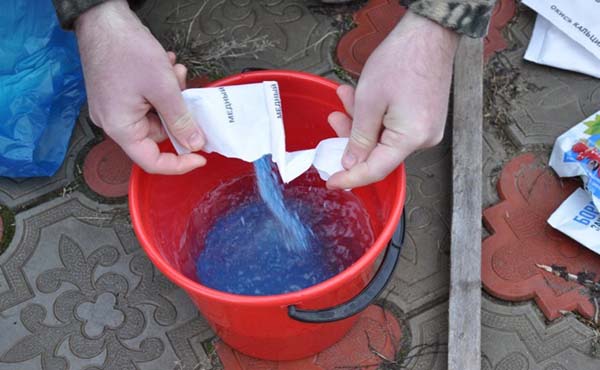
- Household and any other solid soap is incompatible with the solution as ironand copper sulfate (copper and iron simply precipitate). Therefore, it is necessary to use liquid soap, for example, any dishwashing detergent is suitable.
- Any preparations based on copper, especially copper sulfate,should not be mixed with other pesticides. Howeverallowed and even recommended use of drugs in tank mixes based on copper and sulfur (for example, colloidal sulfur, "Tiovit Jet").
- It is not necessary to use a solution of copper sulfate immediately... In theory, it can be stored as long as you like, but that doesn't make much sense.
- Usually, copper sulfate and Bordeaux mixture (when you prepare the solution, it is already called bordeaux liquid) apply exactly in the spring. In autumn they use inkstone.
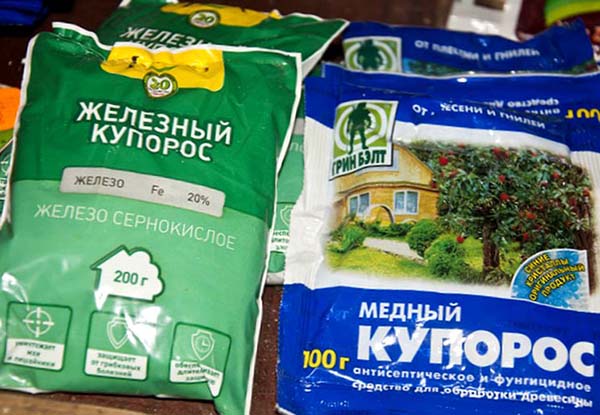
Worth knowing! Copper tends to accumulate in the soil. But since the treatments are foliar, they will go to the compost at the most, along with plant residues. Compost, as a rule, is distributed in rather small doses throughout the garden, therefore, with foliar treatments, the ingress of copper into the soil is minimized.
Safety precautions when using copper sulfate
When preparing a solution of copper sulfate and carrying out processing, you should know and adhere to some rules and precautions:
- Copper sulfate belongs to the substances of the 2nd hazard class. Non flammable, fire and explosion proof.
- Observe the recommended concentration of the solution. Excess threatens negative consequences for your plants (the product is really strong and can easily burn plants).
- Processing is recommended in protective clothing (dressing gown), gloves (rubber), glasses, respirator (if possible)and preferably inheaddress (in a cap or scarf).
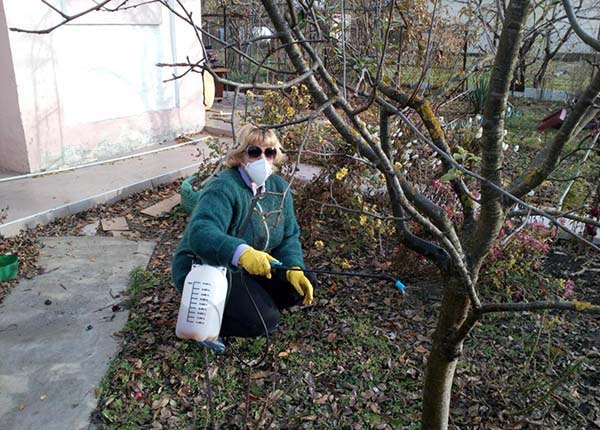
- If during spraying or preparation the solution gets in your eyes or on your skin then urgently a place is needed rinse with clean tap water.
Also highly recommended after treatment, wash hands and face with soap and water.
- If a solid or concentrated solution enters the gastrointestinal tract, it is necessary to flush the victim's stomach with a 0.1% solution of potassium permanganate, give a saline laxative - magnesium sulfate (1-2 tablespoons) to drink, induce vomiting, give a diuretic. In addition, the ingestion of anhydrous substance in the mouth and stomach can cause thermal burns.
- If copper sulfate enters through the respiratory tract in the form of an aerosol, it is necessary to take the victim to fresh air, rinse the mouth with water and rinse the wings of the nose.
To save energy and achieve the best results, it is very useful to use copper sulfate in the garden and vegetable garden. To do this, it is necessary to study information about the various areas of its application and the corresponding rules for carrying out treatments (especially the proportions for breeding). And also always remember about safety measures during the preparation of the solution and direct spraying.
Important! As a rule, it is much more often used to combat fungal diseases and grape phylloxera bordeaux mix (Bordeaux liquid solution), which contains copper sulfate, as well as lime. This agent penetrates into the plant and lingers there, even if it rains.
Video: what is copper sulfate and what is it used for in gardening and horticulture


Good